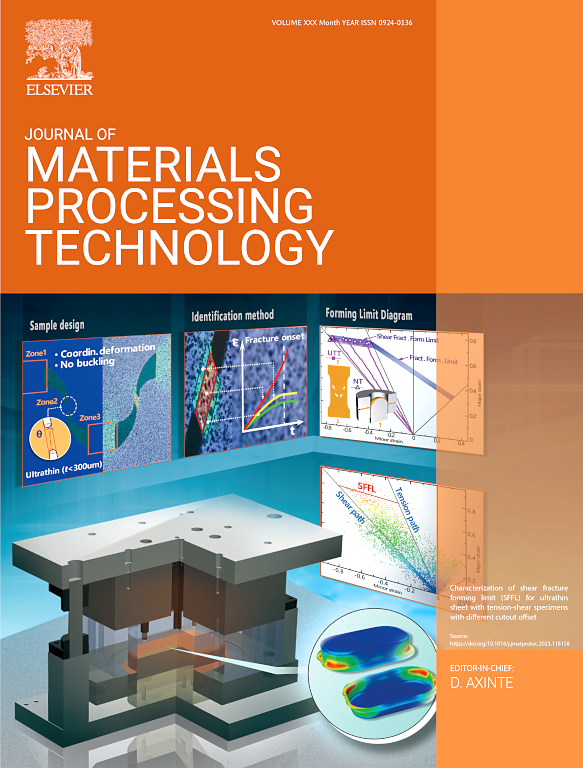Microstructural mechanisms and mechanical behavior of friction-stir-welded Mg alloy laminate joints
IF 6.7
2区 材料科学
Q1 ENGINEERING, INDUSTRIAL
Journal of Materials Processing Technology
Pub Date : 2025-02-17
DOI:10.1016/j.jmatprotec.2025.118779
引用次数: 0
Abstract
Achieving reliable welding of multi-layered magnesium laminates is pivotal for advancing lightweight structural applications in energy-efficient transportation. However, the welding process and resultant joint properties of such complex laminates are issues of concern in material processing. This study aims to investigate the generic scientific principles governing the weldability and mechanical behavior of multi-layered Mg laminates using friction stir welding as a case study. An AZ31/Mg-6Zn-1Mn-2Gd/AZ31 laminate was successfully welded at 1000 rpm (rotation speed)–100 mm/min (welding speed) but not at 800 rpm–100 mm/min. The microstructural evolution, deformation behavior, and mechanical properties of the laminate joints were systematically investigated. The results indicated that both the AZ31 and Mg-6Zn-1Mn-2Gd layers in the laminate joint presented an approximately symmetrical texture distribution from the advancing side to the retreating side, with the texture intensity of the AZ31 layer higher than that of the Mg-6Zn-1Mn-2Gd layer. Tensile testing revealed strain localization, with mechanical properties (yield strength: 119 MPa, ultimate tensile strength: 211 MPa, elongation: 6.1 %) between single-material AZ31 and Mg-6Zn-1Mn-2Gd joints but worse than those of the initial laminate. The laminate joint ultimately fractured near the nugget zone interface on the advancing side. This was attributed to the fluctuation in the Schmid factor for basal slip and extension twinning, which were determined by the texture distribution. The current investigation provides insights into the correlation among the process parameters, microstructural evolution, and mechanical performance of Mg alloy laminate joints.
搅拌摩擦焊接镁合金层压板接头的组织机理及力学性能
实现可靠的多层镁层压板焊接是推进节能运输中轻量化结构应用的关键。然而,这种复杂层压板的焊接工艺及其接头性能是材料加工中关注的问题。本研究以搅拌摩擦焊为例,探讨了控制多层Mg层合板可焊性和力学行为的一般科学原理。在1000 rpm(转速)-100 mm/min(焊接速度)下成功焊接了AZ31/Mg-6Zn-1Mn-2Gd/AZ31层板,但在800 rpm -100 mm/min下焊接失败。系统地研究了层合接头的组织演变、变形行为和力学性能。结果表明:层状接头中AZ31和Mg-6Zn-1Mn-2Gd层均呈现由前进侧向后退侧近似对称的织构分布,且AZ31层的织构强度高于Mg-6Zn-1Mn-2Gd层;拉伸试验显示应变局部化,单材料AZ31和Mg-6Zn-1Mn-2Gd接头的力学性能(屈服强度为119 MPa,极限抗拉强度为211 MPa,伸长率为6.1 %)低于初始层合板。层状节理最终在推进侧靠近熔核带界面处断裂。这是由织构分布决定的基底滑移和延伸孪晶的施密德因子波动所致。本研究为进一步了解镁合金层合接头的工艺参数、微观组织演变与力学性能之间的关系提供了新的思路。
本文章由计算机程序翻译,如有差异,请以英文原文为准。
求助全文
约1分钟内获得全文
求助全文
来源期刊

Journal of Materials Processing Technology
工程技术-材料科学:综合
CiteScore
12.60
自引率
4.80%
发文量
403
审稿时长
29 days
期刊介绍:
The Journal of Materials Processing Technology covers the processing techniques used in manufacturing components from metals and other materials. The journal aims to publish full research papers of original, significant and rigorous work and so to contribute to increased production efficiency and improved component performance.
Areas of interest to the journal include:
• Casting, forming and machining
• Additive processing and joining technologies
• The evolution of material properties under the specific conditions met in manufacturing processes
• Surface engineering when it relates specifically to a manufacturing process
• Design and behavior of equipment and tools.
 求助内容:
求助内容: 应助结果提醒方式:
应助结果提醒方式:


